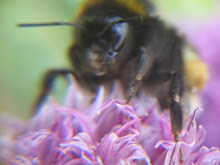

I just spent the last two hours sorting through my dead bee specimens that i've been collecting.
I started to collect dead insects for a different project in 2005 and since then have continued to gather flies, wasps, bees, dragonflies, moths and butterflies etc from window sills and pavements.
At Yorkshire Sculpture Park I was able to retrieve all the dead honeybees from around the hive entrances, plus i also collected any dead bumblebees from the park and also any i saw off site during the summer.
For the exhibition I want to present some of the dead specimens in one of the gallery walls, so i spent this afternoon sorting through them all. I can't tell you the stench in the boxes of bees - a really nasty smell. Some of them are half eaten and battered with wings, legs or heads missing, but some are perfectly whole and really beautiful to look at.

If you want to preserve them you need to either dry them completely or freeze them. It's a pity we don't have more collections of dead insects. Right now there's a question about whether or not a 'new' bee pathogen - Nosema cerana - really is new. Older collections of dead bees would very soon answer that one.
ReplyDelete